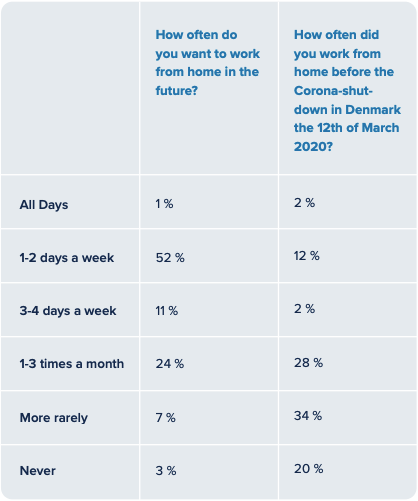Working from home might be old news to you. But how to create an actual efficient workplace at home or remote can be a challenge.
Home is usually the place you relax, and that is why you easily get the feeling that you should not work at all. Or the other way around, you can keep working a little all the time, which is not efficient at all, because your brain also needs breaks to get into that lovely focus mode that gets the job done. Here are 10 tips to create a home office or remote office that helps you get a more efficient workday.
Learn more about the future of work
Ten Tips to Create an Efficient Home Office
- Make a dedicated workspace - preferably one where you can shut the door and dirty dishes are out of sight
- Put on your ‘uniform’ - wear the clothes you typically would wear in the office. PJs and sweatpants are associated with time off.
- Set specific work hours - and stick to them. In this way, you enjoy your time off with good conscience.
- Make a to-do list - it creates an overview of the daily tasks, and it feels good when they are ticked off.
- Limit distractions - close your social media tabs, shut the TV, and do not start a beeping washing machine
- Check-in with your colleagues virtually for the sake of your social life and efficiency too. Remember to book specific meetings for the social part of work
- Eat lunch away from your workspace. A focused and efficient brain needs breaks too.
- Get some air. Take a walk and refresh your brain with a break.
- “Go home”. When your workday is done, move away from your workstation and shut everything down. Out of sight, out of mind.
- Get physical - both in terms of physical activity and giving your kid, spouse, or roommate an extra hug. Stay close to home.
People Want to Work More from Home
A recent study from the Danish Union, Djøf, shows that people want to work more from home, but maybe not in the way you might think. So, maybe it is time to think about even more flexible work forms to keep up the employee engagement. The stats go:
 Methods to Reach your Goals
Methods to Reach your Goals
Focus is important to reach your goals and finish up a task before a deadline. This sends out great satisfaction to you and is a motivation-booster to your work life. However, in our digital age, there are many distractions keeping us away from focus and therefore, the great satisfaction of completing a (difficult) task. The distractions make our brain practice bad habits, instead of the good that keeps us in focus. But fortunately, there are more methods and tips to get your brain back on track and bring the focus back to your workday.
Smaller Projects - Pomodoro
Pomodoro is the Italian word for tomato, which might not make a lot of sense to you when thinking of gaining more focus. But maybe, if you think about a little tomato-timer, which you might have used before your smartphone when you had to boil an egg once. The Pomodoro technique is created by Francesco Cirillo and designed to boost your focus on one simple task only by splitting the task into time slots of 25 minutes, followed by a 5-minute break, and then working on the task for 25 minutes again.
At the time, you are working on the task, you must not check your mail or let yourself get interrupted by co-workers or yourself by, for example, picking up your smartphone and checking Instagram. A lot of smaller apps, for example, the sound app Noisli, have already implemented the Pomodoro technique in their software. Noisli is an app where you can mix up different sounds to boost focus, and by using their Pomodoro feature, the sounds will slowly volume down after 25 minutes, meaning that now it is time for a break.
The Pomodoro technique is great to use when you have to finish up smaller projects, but larger ones as too, if you practice well. In Learningbank we are currently trying out the Pomodoro technique on a larger scale in our office. Here, selected employees have received their own timer which turns red, when the particular employee is in focus mode. The red light means that the rest of the co-workers must not interrupt the employee in the focus mode. This is a way to limit distractions during a workday.
Big Projects - 3-3-6-3
The Danish freelance PR consultant Pernille Garde Abildgaard has developed a method to maintain focus and reach your goals. It is called the 3-3-6-3 method but can easily be replaced with some other numbers based on your needs.
The method means that she spends 3 morning hours, 3 days a week for 6 months minimum to achieve a goal, for example, writing a book. In the time slot blocked to research and write the book she has 3 rules: no phone, no mail, and no exceptions. By following this method and planning the time slots according to the 6-month deadline, you can as an individual, get a home run when closing a big project. And especially, limiting the distractions of our digital, modern world can be extremely valuable.
Need to get your tips to work remotely from a human being? See the video below with our Psychologist & Learning Specialist Malene, who has worked as a remote worker for two years. She is definitely an experienced remote worker – and she’ll share some quick tips on how she makes it work.
Want to know more about how to cope with all the changes post COVID-19 and move into the future work life? Download our free guide below made in co-operation with Insights:


